It has been a while since I posted on my blog. I have decided to write again to share some of the interesting topics I have come across. I recently read a very interesting write up from Pete Bell from Endeca published on KM World: Acmepedia: a case study in Wikis, Facets and KM. Pete makes some very interesting observations.
Regarding the key differences between Wikis and traditional KM:
• Wikis are an addition to KM, not a rip-and-replace. They will become yet another silo if they’re not designed to complement your existing enterprise packaged applications.
• Faceted navigation and information access can be the key to crossing different content silos.
• Although facets are part of the solution, they also introduce new requirements: how do you categorize everything so it can be found again through faceted navigation? With enhancements, tagging and folksonomy provide an answer.
• Authority and trust impose different constraints in the enterprise than in the public Wikipedia. Facets offer dramatic changes here too.
Best practices for Wikis:
• “Curated” content: Only a utopian would expect white papers, legal documents and HR forms to be produced by the proverbial million monkeys banging on a wiki. These would continue to live in a CMS, complete with version control, workflows and the like.
• Packaged applications: Data and notes from CRM, HRM and ERP packaged applications were some of our most valuable content. We would sensibly leave it where it was, but use information access to integrate it.
• Wikis and blogs: These group collaborations proved best at capturing the conversational nature of emerging topics, discussions, threads, opinions, ephemera and niches. And they required some business
process changes to align them with communities of practice.
Folksonomy and Taxonomy:
In our own experimentation, we found that the purists’ folksonomy can be amended very successfully with a pragmatic approach. It can succeed by blending elements of tops-down and bottoms-up organization. Key techniques:
• Controlled vocabulary: instead of free-form document tagging, first prompt users to select common terms from a controlled vocabulary, like names of industries, products, customers and geographies.
• Enter tags in facets: Instead of prompting for tags in a single field, offer faceted fields—again, like industries, products, etc. The name of the facet itself adds valuable structure.
• Auto-complete terms: Prevent vocabulary drift by using a type-ahead search to suggest known terms as the user types.
• Put an editor in the workflow queue: Actively prevent vocabulary drift with an expert. It takes less effort than you’d expect. You won’t catch everything, but you can add common synonyms and hesaurus
terms, and promote frequently used terms to the controlled vocabulary.
• Auto-tag: Supplement user tagging with some based on rules, like tags derived from an author’s department or LDAP profile.
Sunday, November 25, 2007
Sunday, March 18, 2007
Finally! My Yahoo is Getting an Upgrade
I have been a long time My Yahoo! user and over time have accumulated quite a collection of personalized content. But lately, with new and innovative services like Netvibes and PageFlakes, I had grown overly frustrated with the lack of investment in My Yahoo! and had been considering migrating away from using it. Finally, it looks like Yahoo! has decided to change course and some exciting new features are coming our way. The new My Yahoo! is currently offered in Beta to a limited number of users. For a preview of what's coming, check out this screencast. Also, Yahoo! is starting a new My Yahoo! blog that will hopefully give users a good sense of where things are going.
So, I guess I will wait a little longer and see if the new My Yahoo! finally gets to par with its competition.
So, I guess I will wait a little longer and see if the new My Yahoo! finally gets to par with its competition.
Saturday, March 10, 2007
Build Your Own Application With Coghead
I have been invited to participate in Coghead beta program. Coghead's catch line is a:
Their application is built using OpenLaszlo and provides a very responsive user experience. I have been evaluating their application and they definitely get the idea right. End users have a multitude of needs for business application. We could refer to this as the long tail of business applications. And IT cannot respond to everyone of those needs in a scalable manner. Therefore it makes sense to create an application that empowers business users to quickly create applications as their needs occur. Coghead Gallery provides a number of application templates to quickly get started.
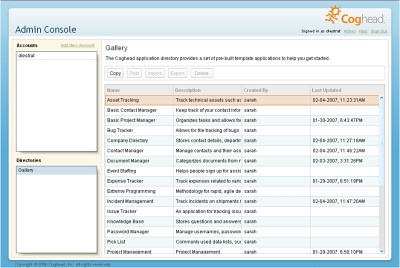
Where I personally find that Coghead falls short is with its concept of collection Coghead allows users to build applications made collections, forms, views, and actions. Collections are objects used by the application. They contain records. A collection describes a data structure, and provides tools for viewing and modifying data of that type. Records are the actual data that is stored; each record is an instance of the data defined by the Collection. For example, if you have a collection “Purchase Orders” then a record would be the data that makes up one purchase order.
Though a powerful concept, it does not go far enough in my opinion. Business application needs go beyond the need to assemble collections. Nevertheless, this is a good start and a nice application.
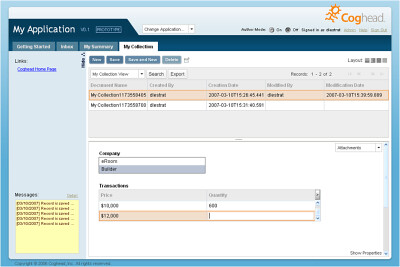
Simple, powerful new way to create web-based business applications that can be used by anyone, anytime, anywhere!
Their application is built using OpenLaszlo and provides a very responsive user experience. I have been evaluating their application and they definitely get the idea right. End users have a multitude of needs for business application. We could refer to this as the long tail of business applications. And IT cannot respond to everyone of those needs in a scalable manner. Therefore it makes sense to create an application that empowers business users to quickly create applications as their needs occur. Coghead Gallery provides a number of application templates to quickly get started.

Where I personally find that Coghead falls short is with its concept of collection Coghead allows users to build applications made collections, forms, views, and actions. Collections are objects used by the application. They contain records. A collection describes a data structure, and provides tools for viewing and modifying data of that type. Records are the actual data that is stored; each record is an instance of the data defined by the Collection. For example, if you have a collection “Purchase Orders” then a record would be the data that makes up one purchase order.
Though a powerful concept, it does not go far enough in my opinion. Business application needs go beyond the need to assemble collections. Nevertheless, this is a good start and a nice application.

Saturday, March 03, 2007
Jetspeed 2.1 Released!
Congratulations to the Jetspeed team who released Jetspeed 2.1 this week-end. Included in this release are a large number of bug fixes and some significant new features including:
All great features that will go a long way to make Jetspeed 2.1 an option for enterprise portal deployments.
The Jetspeed 2.1 release comes with a nice installer and you can try it for yourself in about 5-10 minutes.

The detailed releases notes are available on Jetspeed-2 web site.
Below is a screenshot of the new Jetspeed-2 desktop client side aggregation.
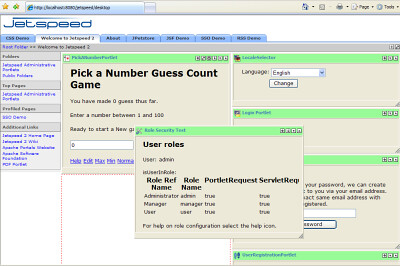
- Jetspeed Desktop: a web 2.0 client-side JSR-168 portlet aggregation
- Parallel Rendering: multithreaded portlet aggregator with portlet timeout tracking and removal of slow rendering portlets
- Jetspeed Distributed Cluster: support for distributed deployments of the portal on multiple application server platforms
- JSR 168 Caching: full caching support of the JSR-168 portlet specification and distributed cache invalidation
- Improved LDAP support: full security maintenance using LDAP is now supported for many LDAP providers
- Full fledge AJAX API
All great features that will go a long way to make Jetspeed 2.1 an option for enterprise portal deployments.
The Jetspeed 2.1 release comes with a nice installer and you can try it for yourself in about 5-10 minutes.

The detailed releases notes are available on Jetspeed-2 web site.
Below is a screenshot of the new Jetspeed-2 desktop client side aggregation.

Thursday, March 01, 2007
Data Sharing and Vizualization: Next Generation
The International Weekly Journal of Science has published an interesting article illustrating how social software us creating a new paradigm for sharing data. Proof in point is IBM's new Many Eyes service launched on January 23rd. The site provides an infrastructure for uploading data sets and creating visualization for the data through various visualization types available.
 By making the data publicly available and providing an infrastructure to analyze it, it empowers individuals and creates a very powerful model for developing collective intelligence quickly. Fernanda Viégas of IBM's Visual Communication Lab in Cambridge, Massachusetts points out that governments, international agencies and research organizations generate huge silos of publicly available data on almost every aspect of society, but the public has never been able to explore, share and discuss these data sets easily. That is interesting, but more interestingly, I could see huge applications of this type of technology to the enterprise with potential dynamic enterprise datasets. In the enterprise context, this type of application of social software could drastically impact organizations' ability to be more data driven and to leverage data to collaborate on business decisions.
By making the data publicly available and providing an infrastructure to analyze it, it empowers individuals and creates a very powerful model for developing collective intelligence quickly. Fernanda Viégas of IBM's Visual Communication Lab in Cambridge, Massachusetts points out that governments, international agencies and research organizations generate huge silos of publicly available data on almost every aspect of society, but the public has never been able to explore, share and discuss these data sets easily. That is interesting, but more interestingly, I could see huge applications of this type of technology to the enterprise with potential dynamic enterprise datasets. In the enterprise context, this type of application of social software could drastically impact organizations' ability to be more data driven and to leverage data to collaborate on business decisions.
Below, some more screenshots from Many Eyes.
Posted visualizations:
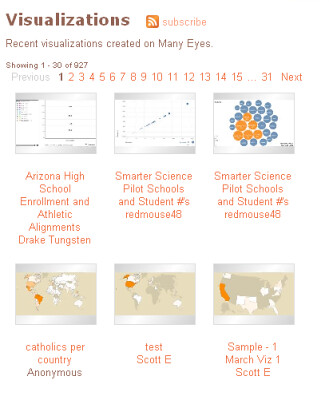
Posted comments:

Posted data sets:

 By making the data publicly available and providing an infrastructure to analyze it, it empowers individuals and creates a very powerful model for developing collective intelligence quickly. Fernanda Viégas of IBM's Visual Communication Lab in Cambridge, Massachusetts points out that governments, international agencies and research organizations generate huge silos of publicly available data on almost every aspect of society, but the public has never been able to explore, share and discuss these data sets easily. That is interesting, but more interestingly, I could see huge applications of this type of technology to the enterprise with potential dynamic enterprise datasets. In the enterprise context, this type of application of social software could drastically impact organizations' ability to be more data driven and to leverage data to collaborate on business decisions.
By making the data publicly available and providing an infrastructure to analyze it, it empowers individuals and creates a very powerful model for developing collective intelligence quickly. Fernanda Viégas of IBM's Visual Communication Lab in Cambridge, Massachusetts points out that governments, international agencies and research organizations generate huge silos of publicly available data on almost every aspect of society, but the public has never been able to explore, share and discuss these data sets easily. That is interesting, but more interestingly, I could see huge applications of this type of technology to the enterprise with potential dynamic enterprise datasets. In the enterprise context, this type of application of social software could drastically impact organizations' ability to be more data driven and to leverage data to collaborate on business decisions.Below, some more screenshots from Many Eyes.
Posted visualizations:

Posted comments:

Posted data sets:

Sunday, February 25, 2007
Online Office Suite - It's Heating Up...
My blog post a couple weeks ago on online office suites was quite timely. Last week, Google announced the re-branding and extended reach of its Google Apps for your Domain. As I pointed out in my previous post, Google's announcement validate in many way the disruptive nature of such offerings. Google's improved offering includes:
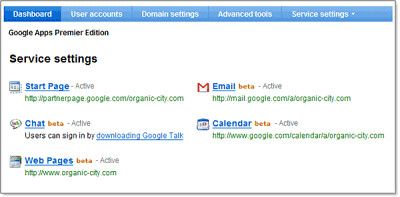
Administrators can:
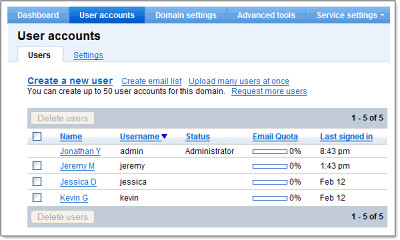
 Not surprisingly, Google Apps also comes with a broad set of APIs that use HTTP requests for a publishing and editing protocol in the spirit of the REST approach to web service interfaces. Most of these APIs allows client applications to view and update Google Apps constructs (e.g. spreadsheets) in the form of Google data API ("GData") feeds. GData leverages either of two standard XML-based syndication formats: Atom or RSS. Such APIs will strongly empower Google's partners and could overtime provide Google with strong competitive differentiation.
Not surprisingly, Google Apps also comes with a broad set of APIs that use HTTP requests for a publishing and editing protocol in the spirit of the REST approach to web service interfaces. Most of these APIs allows client applications to view and update Google Apps constructs (e.g. spreadsheets) in the form of Google data API ("GData") feeds. GData leverages either of two standard XML-based syndication formats: Atom or RSS. Such APIs will strongly empower Google's partners and could overtime provide Google with strong competitive differentiation.
From the end user standpoint, Google Apps Premier Edition is all about collaboration, with 2 main positioning statements:

This may explain some of the early broad adoption Google is claiming. Kevin Gough, product manager for Google Enterprise observes that:
Early in its release of Google Apps Premier Edition, Google claims that a number of large enterprises have commenced deployment and pilots of the online system that is looming as a threat to Microsoft's desktop-based office productivity dominance.
The coming year will be interesting to watch and should create plenty of opportunities for those who can seize them.
- Google Apps Standard Edition: a free service that includes Gmail accounts (since enhanced for mobile access on BlackBerrys), a shared calendar, Google Talk instant messaging, access to Google Docs & Spreadsheets, and a Web page creator.
- Google Apps Premier Edition: a service designed for businesses of all sizes (read: targeted at the enterprise) which costs $50 a year per user and includes a 99.9% uptime guarantee for e-mail, additional e-mail storage (10GB per account instead of the 2GB limit of the Standard Edition), and new administration and business integration features.

Administrators can:
- Add, change, or remove user accounts
- Create the Start page layout for their user base where users can quickly preview their inbox, calendar, document list and other essential information related to their organization.
- Run a chat session
- Design a Web site
- Set up e-mail accounts
- Define mailing lists (you can include recipients outside your domain)
- Configure calendars

 Not surprisingly, Google Apps also comes with a broad set of APIs that use HTTP requests for a publishing and editing protocol in the spirit of the REST approach to web service interfaces. Most of these APIs allows client applications to view and update Google Apps constructs (e.g. spreadsheets) in the form of Google data API ("GData") feeds. GData leverages either of two standard XML-based syndication formats: Atom or RSS. Such APIs will strongly empower Google's partners and could overtime provide Google with strong competitive differentiation.
Not surprisingly, Google Apps also comes with a broad set of APIs that use HTTP requests for a publishing and editing protocol in the spirit of the REST approach to web service interfaces. Most of these APIs allows client applications to view and update Google Apps constructs (e.g. spreadsheets) in the form of Google data API ("GData") feeds. GData leverages either of two standard XML-based syndication formats: Atom or RSS. Such APIs will strongly empower Google's partners and could overtime provide Google with strong competitive differentiation.From the end user standpoint, Google Apps Premier Edition is all about collaboration, with 2 main positioning statements:
- Communicate and connect: This includes GMail, Google Talk and Google Calendar
- Collaborate and Publish: This includes Google Docs and Spreadsheet, the Start Page and Google Page Creator

This may explain some of the early broad adoption Google is claiming. Kevin Gough, product manager for Google Enterprise observes that:
CIOs are increasingly looking at what can they safely outsource to a trusted partner and what is a core function that is going to give them a competitive differentiator. They’re realizing that email and productivity tools and the staff that have to maintain that is not a competitive differentiator for them and they can redeploy that staff on things that are more core to their business.
Early in its release of Google Apps Premier Edition, Google claims that a number of large enterprises have commenced deployment and pilots of the online system that is looming as a threat to Microsoft's desktop-based office productivity dominance.
We have hundreds of thousands of small to medium businesses that have already done that," said Gough. "They’ve already switched their entire infrastructure over to Google Apps. We have just released the Premier Edition of Google Apps today and today we already have GE, Procter & Gamble, Prudential and Loreal. If on the first day of the launch we have two of the top 25 companies in the world. Imagine what’s going to happen in a month or a year from now.
The coming year will be interesting to watch and should create plenty of opportunities for those who can seize them.
Saturday, February 17, 2007
Digg Like User Interface as a Product Management Tool
Yahoo!'s Yodel Anecdotal blog provides an interesting take on gathering user's feedback. Yahoo! has built a brand new Yahoo! Suggestion Board to collect users' feedback for its various web properties.
 From a product management stand point, this is a great use of the Digg concept. Instead of providing the traditional disconnected feedback form where users provide feedbacks one at a time without any understanding or context of previously submitted feedback, the Yahoo! Suggestion Board concept provides an avenue to directly involve users in the prioritization of features/enhancements by letting them vote, comment, and make suggestions on what really matters to them. This is a great use of community building and the architecture of participation to better listen to the voice of your customers and make your users the drivers for how a company's products should evolve.
From a product management stand point, this is a great use of the Digg concept. Instead of providing the traditional disconnected feedback form where users provide feedbacks one at a time without any understanding or context of previously submitted feedback, the Yahoo! Suggestion Board concept provides an avenue to directly involve users in the prioritization of features/enhancements by letting them vote, comment, and make suggestions on what really matters to them. This is a great use of community building and the architecture of participation to better listen to the voice of your customers and make your users the drivers for how a company's products should evolve.
Yahoo! is getting quite an earful for reaping off the Digg user interface, but this is a creative a powerful use of such concept to put users' at the center of future products enhancements.
 From a product management stand point, this is a great use of the Digg concept. Instead of providing the traditional disconnected feedback form where users provide feedbacks one at a time without any understanding or context of previously submitted feedback, the Yahoo! Suggestion Board concept provides an avenue to directly involve users in the prioritization of features/enhancements by letting them vote, comment, and make suggestions on what really matters to them. This is a great use of community building and the architecture of participation to better listen to the voice of your customers and make your users the drivers for how a company's products should evolve.
From a product management stand point, this is a great use of the Digg concept. Instead of providing the traditional disconnected feedback form where users provide feedbacks one at a time without any understanding or context of previously submitted feedback, the Yahoo! Suggestion Board concept provides an avenue to directly involve users in the prioritization of features/enhancements by letting them vote, comment, and make suggestions on what really matters to them. This is a great use of community building and the architecture of participation to better listen to the voice of your customers and make your users the drivers for how a company's products should evolve.Yahoo! is getting quite an earful for reaping off the Digg user interface, but this is a creative a powerful use of such concept to put users' at the center of future products enhancements.
Sunday, February 11, 2007
Online Office Suites - Part 1
There has been a lot of talk lately about online office suites, or Office 2.0, with the mandatory 2.0 moniker. The acquisition of Writely by Google in early March 2006 rekindled speculations that online office suites where back for good and provided a real threat to the dominant Microsoft Office position.
I believe there are some strong arguments for this, this time. If we take the new entrants in that space through a classic Clayton Christensen analysis, new online office suites clearly have new market disruptions characteristics. Compared to Microsoft Office, they provide:
Over the next few weeks, I will take a look at a few of those online Office suites.
I believe there are some strong arguments for this, this time. If we take the new entrants in that space through a classic Clayton Christensen analysis, new online office suites clearly have new market disruptions characteristics. Compared to Microsoft Office, they provide:
- Lower performance in "traditional attributes" but improved performance in new attributes, simplicity and convenience
- Target non-consumption: customers who historically lacked the money or skill to buy or use the product. The standard version of Office costs about $400 where most online office suites are typically free.
- The business model of these new entrants make money at a much lower price per unit sold.
Over the next few weeks, I will take a look at a few of those online Office suites.
Saturday, February 10, 2007
Mashup for the Enterprise? A look at QEDWiki
IBM announced early February the release of QEDWiki for the Enterprise. QED stands for "Quickly and Easily Done" and is intended to be a tool for mashups in the enterprise. As IBM puts it:
To see QEDWiki in action, check out an introduction and an insurance claims use case videos on YouTube.
With QEDWiki, Lotus Connection and Lotus Quickr, IBM has been riding the Enterprise 2.0 wave at full speed. Those products are definitely innovative and very interesting. It just bodes the question on how do you position one versus the other versus Websphere Portal, Quickplace and Workplace if you are an IBM sales rep...
QEDWiki is a browser-based assembly canvas used to create simple mash-ups. A mash-up maker is an assembly environment in which the creator of a mash-up uses software components (or services) made available by content providers. QEDWiki is a unique Wiki framework in that it provides both Web users and developers with a single Web application framework for hosting and developing a broad range of Web 2.0 applications.
QEDWiki also provides Web application developers with a flexible and extensible framework to enable do-it-yourself (DIY) rapid prototyping. Business users can quickly prototype and build ad hoc applications without depending on software engineers. QEDWiki provides mash-up enablers (programmers) with a framework for building reusable, tag-based commands. These commands (or widgets) can then be used by business users who wish to create their own Web applications.
To see QEDWiki in action, check out an introduction and an insurance claims use case videos on YouTube.
With QEDWiki, Lotus Connection and Lotus Quickr, IBM has been riding the Enterprise 2.0 wave at full speed. Those products are definitely innovative and very interesting. It just bodes the question on how do you position one versus the other versus Websphere Portal, Quickplace and Workplace if you are an IBM sales rep...
Thursday, February 08, 2007
Web 2.0... The Machine is Us/ing Us
I came across a video produced by Michael Wesch, Assistant Professor of Cultural Anthropology from Kansas State University that I found to be very well done. Instead of looking at Web 2.0 through the usual lenses of collaboration, social networking, wikis and folksonomies, it takes a fresh time machine approach to describing how end users became the engine of the Internet and some of the societal questions that result from this transformation. This is very refreshing.
A transcript is available on Digital Ethnography's blog.
A transcript is available on Digital Ethnography's blog.
Friday, February 02, 2007
Internet Users and Tagging
The Pew Internet & American Life Project just published a report on tagging. Some very interesting findings from the report:
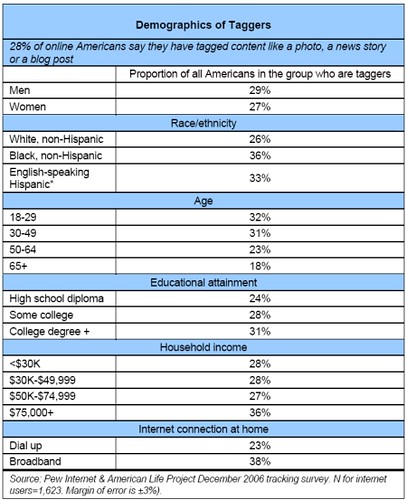
In his upcoming book, Everything Is Miscellaneous: The Power of the New Digital Disorder,
Weinberger describes how radical it is for people to move away from hierarchical classifications. His prediction:
- A December 2006 survey by the Pew Internet & American Life Project has found that 28% of internet users have tagged or categorized content online such as photos, news stories or blog posts. On a typical day online, 7% of internet users say they tag or categorize online content.
- Taggers look like classic early adopters of technology. They are more likely to be under age 40, and have higher levels of education and income.
- Taggers are considerably more likely to have broadband connections at home, rather than dial-up connections. Men and women are equally likely to be taggers, while online minorities are a bit more likely than whites to be taggers.
- The act of tagging is likely to be embraced by a more mainstream population in the future because many organizations are making it easier and easier to tag internet content.

In his upcoming book, Everything Is Miscellaneous: The Power of the New Digital Disorder,
Weinberger describes how radical it is for people to move away from hierarchical classifications. His prediction:
We'll also undoubtedly figure out how to intersect tags with social networks, so that the tags created by people we know and respect have more “weight” when we search for tagged items. In fact, by analyzing how various social groups use tags, we can do better at understanding how seemingly different worldviews map to one another.
Saturday, January 27, 2007
The New Era of The Long Tail of the Pharmaceutical Industry?
I came across a good article on the New York Times this morning, The Dangers of Swinging for the Fences by Joe Nocera. Reading this article, I could not help but think whether the pharmaceutical industry had entered a new era where addressing the long tail of drugs production would be the next evolution for that industry.
Joe Nocera makes the point in his article that the pharmaceutical business is changing. This is particularly well illustrated by the tough times at Pfizer. The modern Pfizer was built on Blockbusters, which is what the industry calls medicines that generate $1 billion or more in annual revenue.
At Pfizer for instance, the top 4 drugs account for 35% of revenue. Lipitor alone with $12.9 billion in annual revenue accounts for 27% of Pfizer's revenue. And with Lipitor coming off patent in 2010, Pfizer needs to worry on how to make up for that blockbuster's revenue.
The blockbuster business model is falling apart - and not only in the pharmaceutical industry by the way. First, big bets like the Lipitor one, require a significant time period to recover the investments to produce such blockbuster and drug patents expire after 17 years. Second, expensive go to market strategies with direct advertising to consumer and doctors are experiencing a backlash.
New business models in the pharmaceutical industry are starting to favor the long tail of drugs where new discoveries tend to be very much targeted and according to Harvard economist David Cutler:
Jeffrey Kindler, CEO of Pfizer is betting on it and wants Pfizer to become as good at developing $500 million drugs as in coming up with new blockbusters. Well, that's a big bet for Pfizer and let's hope with Pfizer can pull it off.
It will make for a much healthier industry and could be the start of a new area of the long tail of the pharmaceutical industry. It will be interesting to watch closely how successful Pfizer is at revolutionizing its industry.
Joe Nocera makes the point in his article that the pharmaceutical business is changing. This is particularly well illustrated by the tough times at Pfizer. The modern Pfizer was built on Blockbusters, which is what the industry calls medicines that generate $1 billion or more in annual revenue.
At Pfizer for instance, the top 4 drugs account for 35% of revenue. Lipitor alone with $12.9 billion in annual revenue accounts for 27% of Pfizer's revenue. And with Lipitor coming off patent in 2010, Pfizer needs to worry on how to make up for that blockbuster's revenue.
The blockbuster business model is falling apart - and not only in the pharmaceutical industry by the way. First, big bets like the Lipitor one, require a significant time period to recover the investments to produce such blockbuster and drug patents expire after 17 years. Second, expensive go to market strategies with direct advertising to consumer and doctors are experiencing a backlash.
New business models in the pharmaceutical industry are starting to favor the long tail of drugs where new discoveries tend to be very much targeted and according to Harvard economist David Cutler:
Drugs are eventually going to be customized for individuals.
Jeffrey Kindler, CEO of Pfizer is betting on it and wants Pfizer to become as good at developing $500 million drugs as in coming up with new blockbusters. Well, that's a big bet for Pfizer and let's hope with Pfizer can pull it off.
It will make for a much healthier industry and could be the start of a new area of the long tail of the pharmaceutical industry. It will be interesting to watch closely how successful Pfizer is at revolutionizing its industry.
Friday, January 26, 2007
The Cost of Ineffective Search
Great article in Network World on the Cost of Ineffective Search. The author starts with a strong punch line:
You think that's bad. think again:
1. Enterprises are not investing much in search
Most companies are under-investing in search compared to other systems such as portals, dashboards, databases and other enterprise systems and are not using the latest search technology. The best search applications use concept searches and very few companies have adopted such technology.
2. 90% of the documents that are created have no useful metadata
Companies for the past 10 years have found it extremely difficult to get employees to add metadata to content.
3. The right data sources are not getting indexed
Companies need to figure out what search is used for (customer service, eDiscovery, etc.) and adapt their search strategy.
The Answer?
The semantic web is viewed as an answer to ineffective search. Recent research from MIT Sloan shows that using semantic search technology will turn up most desired results about 80% of the time compared to 50% of the time with search technology used by most companies today.
Improved metadata through a non-intrusive tagging process will definitely contribute to improved search as well, further indicating the value of social tagging.
A company that employs 1,000 information workers can expect more than $5 million in annual salary costs to go down the drain because of the time wasted looking for information and not finding it, IDC research found last year.
You think that's bad. think again:
A survey conducted by Accenture this month of 1,000 middle managers found that more than half of the information they find during searches is useless.
- The Butler Group estimates that 10% of a company's salary are wasted on ineffective searches.* Susan Feldman at IDC found that 3.5 hours each week are wasted on search that don't turn up the right information.
- People spend about 9-10 hours a week on average looking for information and don't find the information they are looking for 1/3 to 1/2 of the time.
1. Enterprises are not investing much in search
Most companies are under-investing in search compared to other systems such as portals, dashboards, databases and other enterprise systems and are not using the latest search technology. The best search applications use concept searches and very few companies have adopted such technology.
2. 90% of the documents that are created have no useful metadata
Companies for the past 10 years have found it extremely difficult to get employees to add metadata to content.
3. The right data sources are not getting indexed
Companies need to figure out what search is used for (customer service, eDiscovery, etc.) and adapt their search strategy.
The Answer?
The semantic web is viewed as an answer to ineffective search. Recent research from MIT Sloan shows that using semantic search technology will turn up most desired results about 80% of the time compared to 50% of the time with search technology used by most companies today.
Improved metadata through a non-intrusive tagging process will definitely contribute to improved search as well, further indicating the value of social tagging.
Tuesday, January 23, 2007
Service-Oriented Information Infrastructure
Mark Lewis had an interesting write up a few days ago on Service Oriented Information Infrastructure (SOII) and I could not agree more with him. Actually, I believe that in many ways this trend has already started. Look at Amazon Simple Storage Services and how sites like SmugMug and YouOs use this infrastructure to essentially run their web sites. You are talking 60,000 customers utilizing 12 GB of storage and 80 GB of bandwidth per month for YouOS and 10 terabytes of new images each month for SmugMug. That's serious infrastructure there. In the case of SmugMug, the company estimates saving $1/2 million a month in storage expenditure!
So, I definitely agree, SOII is the way of the future for the storage industry, looking at Amazon S3 strategy is actually enlightening.
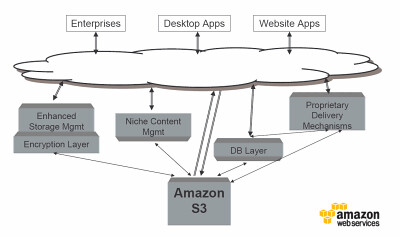
This actually strongly highlights the need for standards in that space. But, then imagine the possibilities: based on the value of their information, customers could either leverage an Amazon S3 services or internal storage for key business records. This also means that application providers need to anticipate such need and layer their product architecture accordingly.
This is starting to happen, Koral, a startup in the content management space is built from the ground up to support storage as a web service and has done a reference implementation using Amazon S3. It will take a while for this type of technology to be adopted in the enterprise, but given the profound impact it will have on established players' product architecture, this clearly has the potential to be a disruptive innovation.
So, I definitely agree, SOII is the way of the future for the storage industry, looking at Amazon S3 strategy is actually enlightening.

This actually strongly highlights the need for standards in that space. But, then imagine the possibilities: based on the value of their information, customers could either leverage an Amazon S3 services or internal storage for key business records. This also means that application providers need to anticipate such need and layer their product architecture accordingly.
This is starting to happen, Koral, a startup in the content management space is built from the ground up to support storage as a web service and has done a reference implementation using Amazon S3. It will take a while for this type of technology to be adopted in the enterprise, but given the profound impact it will have on established players' product architecture, this clearly has the potential to be a disruptive innovation.
Saturday, January 20, 2007
The Value of Co-Creation
I have been reading Wikinomics by Don Tapscott and Anthony Williams. Overall, it is a good book. One of the arguments the authors make is that corporations need highly permeable boundaries to foster innovation in their organizations and be successful. In the software industry, we have seen how IBM and others have leveraged the open source movement to co-create and drive innovation in the industry. IBM for instance estimates that it saves in R&D around $1 billion a year by investing in the Linux community. And in its hardware business alone, IBM sold $2 billion worth of Linux based hardware in 2006. Those make strong arguments for the value of co-creation, right? Well, wait to hear how P&G leverages co-creation. In the late 1990's, P&G realized that out of a $1.5 billion R&D budget, generating a lot of patents, less than 10% of the produced patents resulted in products. So P&G's CEO, A. G. Lafley, set out a pretty aggressive goal: that 50% of P&G new products and service ideas come from outside the company by 2010. We aren't talking about outsourcing here, but true co-creation. Identify most promising ideas out there that help P&G innovate and incorporate them into P&G R&D.
The result is big time dividend as mentioned in P&G's New Innovation Model in March 2006, by Larry Huston and Nabil Sakkab on HBS Working Knowledge.
That's pretty amazing and should be a call for action for any executive out there. Co-creation works in a big way!
The result is big time dividend as mentioned in P&G's New Innovation Model in March 2006, by Larry Huston and Nabil Sakkab on HBS Working Knowledge.
More than 35 percent of our new products in market have elements that originated from outside P&G, up from about 15 percent in 2000. And 45 percent of the initiatives in our product development portfolio have key elements that were discovered externally. Through connect and develop—along with improvements in other aspects of innovation related to product cost, design, and marketing—our R&D productivity has increased by nearly 60 percent. Our innovation success rate has more than doubled, while the cost of innovation has fallen. R&D investment as a percentage of sales is down from 4.8 percent in 2000 to 3.4 percent today. And, in the last two years, we've launched more than 100 new products for which some aspect of execution came from outside the company. Five years after the company's stock collapse in 2000, we have doubled our share price and have a portfolio of twenty-two billion-dollar brands.
That's pretty amazing and should be a call for action for any executive out there. Co-creation works in a big way!
Saturday, January 13, 2007
What do the "Out There" People in Your Organization Think?
The Attention Company posted an interesting survey on what it calls the "Out There" people. See the "Out There" survey and the "Out There" reactions.
In a nutshell, the survey makes the following points as described below:
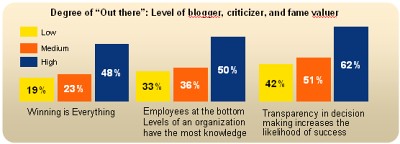
These points are particularly interesting when put in context with organizations and how better information sharing techniques can help organization perform better. This shows the benefits of having a strategy to best disseminate information and knowledge within a company.
In a nutshell, the survey makes the following points as described below:
- The "Out There" people are the ones "participating in online communities"
- 20% of your organization population very active
- 32% are somehow active
- They are the winners in your organization
- Information is everything:
- Employees at the bottom levels of an organization have most of the knowledge
- Transparency in decision making increases the likelihood of success

These points are particularly interesting when put in context with organizations and how better information sharing techniques can help organization perform better. This shows the benefits of having a strategy to best disseminate information and knowledge within a company.
Monday, January 08, 2007
Confluence: A Nice Product Evolution
I have been tracking Confluence for a little while now, I have to give credit to their team for a nice product evolution.
In 2.0 in November 2005, they added label or tagging support with cloud display and improved their dashboard display. See their 2.0 release notes.

More screenshots are available in this slide show.
In April 2006, in their 2.2 version, they added support for personal spaces. See the 2.2 release notes.

And, this January, they are adding people directories in 2.3. See their 2.3 release notes.

For those interested in getting in touch with their developers, some of their personal spaces are available online.
In 2.0 in November 2005, they added label or tagging support with cloud display and improved their dashboard display. See their 2.0 release notes.

More screenshots are available in this slide show.
In April 2006, in their 2.2 version, they added support for personal spaces. See the 2.2 release notes.

And, this January, they are adding people directories in 2.3. See their 2.3 release notes.

For those interested in getting in touch with their developers, some of their personal spaces are available online.
Subscribe to:
Posts (Atom)